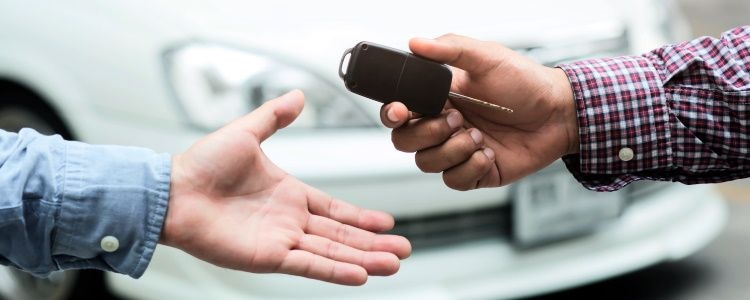Returning a vehicle to the dealership isn’t as simple as returning a shirt that didn’t fit right. Once you sign your loan contract the only way out is to pay it off, but how you do that is up to you. If you’re in a position where you need to return a car, you may have a few options, but your loan balance plays a key role in what those options are.

Can You Return a Financed Car Back to the Dealer?
Can You Return a Car to the Dealer?
The hard truth is that most auto dealerships aren’t going to let you return a vehicle that you're financing. Some dealers have a return policy – sometimes around a seven-day guarantee when you’re financing a car sight-unseen without a test drive – but most don’t offer one. It doesn’t hurt to give your dealer a call and ask, but most franchised dealerships don’t have return policies.

When you finance a vehicle with an auto loan, the car’s title has a lien on it, which names the lender as the lienholder. This gives them ownership rights and prevents you from selling the vehicle until the loan is paid off. Once the loan is complete, though, the lien is removed and the car is yours. If you need to get out of the auto loan before your loan term is over, you can sell the vehicle privately or to a dealership and pay off the car loan.
Options for Getting Out of a Financed Vehicle
If you need to get out of your current auto loan you typically have few options, depending on whether you have a loan, or if you own the vehicle outright.
Selling Your Financed Vehicle
Selling the vehicle to a private party may get you enough money to pay off the auto loan pretty easily, but if not you have to pay the remaining balance out of pocket to release the lien from your lender. If you try to sell it back to the dealership, they may not offer you as much as you can get through a private sale. Trade-in values are typically less than the actual cash value (ACV) of the vehicle. However, right now, with current inventory shortages, your car may be worth more than usual. Be sure to get a few quotes from dealers and online valuation sites before accepting the first offer.
If you find yourself in a negative equity position where you owe more on the car loan than the vehicle is worth, you may have a more difficult time selling the car early to repay your loan. However, if you’re in this position, you still may have a way to get out of the loan and get into another vehicle.
Rolling Over Your Auto Loan
Some auto lenders offer loan rollovers. You simply add the remaining balance of your current car loan onto your next one. It works like this: say you have an auto loan with a balance of $15,000, and you want another vehicle that’s selling for $16,000. You sell your car back to the dealer because it’s not the right fit for you, but the dealership only offers you $10,000 for it. That $5,000 you owe that the sale of the car isn't covering is negative equity and it still needs to be paid, so it’s added to your next auto loan balance of $16,000, turning the balance into a grand total of $21,000.
While you got to sell your vehicle and get into something else, you’re starting out a loan with a lot of negative equity. If you need to sell this next car for something else, it means you may have to roll over negative equity again … and maybe again. This is called the trade-in treadmill, and once you get on it, it’s hard to get off.
Rolling over negative equity onto your next auto loan should be considered one of the last resorts if you really need to sell your vehicle. However, there is one actual last resort if you want out of your car loan.
Voluntary Repossession is the Last Resort Option
If you can’t sell the vehicle to a private party, a dealer won’t buy it, and you don’t have the option to roll over your auto loan, then you may have to consider voluntarily surrendering the car to the dealership.
This is commonly called voluntary repossession. Voluntary or not, it’s classified as a repossession on your credit reports. Once you return the vehicle, it’s considered a default because you’re no longer making payments. The car is then prepped to be sold at auction, and the proceeds from that are applied to your remaining loan balance. If the loan isn’t completely paid off or has a deficiency balance, you still owe that to the lender.
A voluntary repossession should be considered a last resort. It will mean having a repossession listed on your credit reports and, possibly to still owe your lender money after the auction. You may be better off making the payments on the vehicle since a repo can make it difficult to get into another auto loan with most lenders for at least a year or two.
Refinancing Your Car Loan
If you’re thinking about returning your car to the dealer because you can’t afford the payments, but still want to keep the vehicle, then consider refinancing the auto loan after one year. Most refinancing lenders consider a car loan for refinancing after hitting that one-year mark.
Refinancing is replacing your current auto loan with another one, hopefully with better terms. Nearly everyone that refinances is looking for a more affordable monthly payment. Refinancing can give you the chance to qualify for a lower interest rate than what you initially got, and it could give you the opportunity to extend your car loan, which lowers the monthly payment as well.
To refinance, you must have had your auto loan for at least one year, and lenders typically require that you haven’t had any missed or late payments on the loan. Generally, your vehicle should have less than 100,000 miles and be less than 10 years old to qualify, too.
Want Help Finding Refinancing?
If you think refinancing is the right path for you, we want to help. Simply fill out our fast, free auto loan refinancing request form to find out what options you may have.

Senior Automotive Financing Editor
Meghan has been writing professionally for over 25 years. She is expertly versed in automotive special financing and pricing analysis, having published hundreds of articles on Auto Credit Express and its sister sites, CarsDirect, and The Car Connection. Read more
Suggested Posts For You
Receive Free Updates
Get the latest credit tips, resources and advice delivered straight to your inbox.













